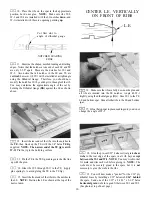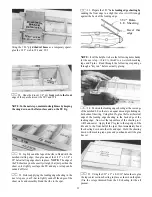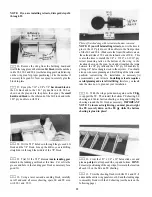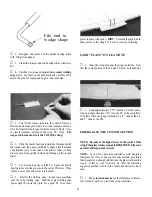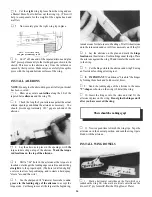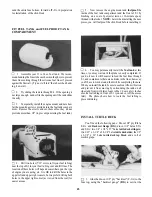
Method 2: Cut threads into the holes you just drilled
using a 6-32 tap and tap wrench. If you use this method you'll
have to supply your own bolts (6-32 x 1" socket head cap
screws) for attaching the engine to the mount. NOTE; 8-32
hardware is recommended if you are installing a 4-cycle
engine.
INSTALL SERVOS AND PUSHROD GUIDE
TUBES
NOTE: Although you may choose to wait until later, this is
the best time to install the pushrod guides, because the
fuselage is wide open and it is very easy to work inside.
IMPORTANT: Before proceeding, plan your servo and
pushrod installation. Especially note which side of the
fuselage the throttle pushrod and nose gear pushrod (if any)
will be located. Remember that the throttle arms of 2-cycle
and some 4-cycle engines are on opposite sides. It will be
helpful to actually sketch your pushrod locations on the plans
with a pencil. It is desireable for the throttle pushrod (and the
nosegear steering pushrod) to run along the sides of the
fuselage. It is also desireable (but not essential) for the rudder
and elevator pushrods to cross inside the fuselage, to avoid
any sharp bends.
1. Set the fuselage upside down on blocks at least
the brass tube method gives a much neater cut). Determine
the location of these holes from the plans. You may chuck
this brass tube in an electric drill to aid in getting through
F-6.
5. Insert the plastic pushrod tubes through the holes
you just cut and through formers F-6, F-5 and F-4.
1-inch high.
2. Trim the 3/16" x 1/2" x 3-5/8" ply servo rails to fit
between the fuse side doublers in the locations shown on the
plan. Temporarily mount your servos to the rails, then glue
the rails to the fuse side doublers. Lock the rails in place by
gluing scraps of plywood on the top and bottom of the rails.
3. Sand the outer surface of the pushrod guide tubes
with 100-grit sandpaper to provide a surface to which the glue
will adhere.
radio installation plan. Temporarily insert the 34"
pushrod wires into the tubes and hold them in the
correct position at the servo end. Keep the tubes as
straight as possible. Glue the tubes to the fuse sides
at the rear exit points using thin CA glue. Use scraps
of 1/8" balsa to anchor the tubes to F-5. Do not anchor
the tubes to F-4 at this time, to allow for slight
adjustment of their positions later.
7. Cut off the tubes at the exit points and sand them
flush with the fuse sides using a sanding block.
8. Temporarily install the engine mount, nosegear
(and nosegear steering arm if you are building a tricycle
configuration).
9. Cut 1/4" off the end of the steering arm, then drill
a 3/16" hole in F-l, just above the outer hole of the arm.
NOTE: The drill should be aimed toward the rudder servo to
avoid tight bends in the pushrod. The photo for this step is at
the top of the next page.
5/32" Collar
6. Route the pushrod tubes according to your
4. Use an Xacto knife to sharpen one end of a piece of
3/16" (outside diameter) brass tubing, then use this tubing to
cut the pushrod exit holes (you may use a 3/16" drill bit, but
Steering Arm
Cut off end
22
6-32 x 1/4" Screw



